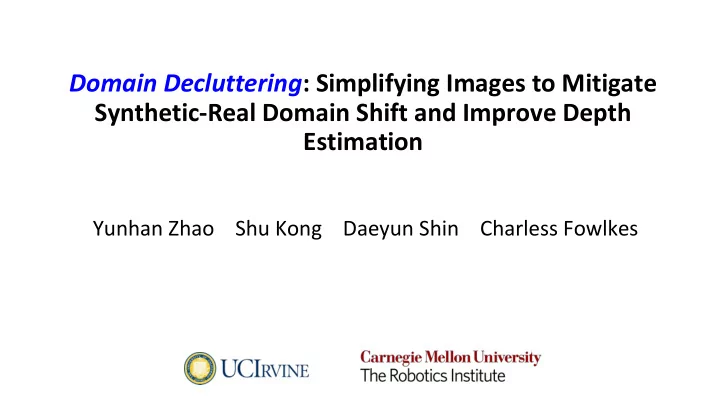

Domain Decluttering : Simplifying Images to Mitigate Synthetic-Real Domain Shift and Improve Depth Estimation Yunhan Zhao Shu Kong Daeyun Shin Charless Fowlkes
Leveraging Synthetic Data in Depth Prediction Motivation & Goal • Existing methods focus on translating images from synthetic-to-real, hoping to close low-level domain real images synthetic images gap ( e.g. , color & texture). • We address the high-level domain gap, such as real-world clutter and novel objects absent in synthetic training data Philosophy - “Admit what you don’t understand” • Decluttering : learn to remove and inpaint "clutter" in real images. • Real-to-synthetic translation of decluttered images to leverage model trained on synthetic data.
Robustness to Clutters and Novel Objects Depth predictor... (a) struggles on an image with " clutter ", e.g., towel as a novel object shown here. (b) may perform worse on a real-to-syn translated version, although translator and depth predictor are trained over large-scale synthetic data. (c) produces much better depth estimate on the decluttered image, even though original regions are modified!
The Proposed Method: Attend-Remove-Complete ( ARC ) We train the ARC model that can automatically ... ● ● Attend to the "cluttered regions" with Translate images from real to synthetic module- A and remove them with module- T Predict depth with module- D ● Complete these regions with module- I ●
Experiment Snippet: ARC performs the best. training set: Baselines: ➢ ➢ 500 real images syn only : train with 5,000 synthetic images ➢ ➢ 5,000 synthetic images real only : train with 500 real images ➢ mix training : train with all above real&syn data testing set: 1,449 real images real images (lower is better) synthetic images ARC [1] Zheng et al. T2net: Synthetic-to-realistic translation for solving single-image depth estimation tasks. ECCV 2018 [2] Chen et al. Crdoco: Pixel-level domain transfer with crossdomain consistency. CVPR 2019 [3] Zhao et al. Geometry-aware symmetric domain adaptation for monocular depth estimation. CVPR 2019
Experiment Snippet: Qualitative Evaluation • Visual improvements are visible in blue regions. • Failure case happens with noticeable ambiguity, e.g. , glass in the red region.
Conclusions Depth-prediction models are not robust to novel objects and ● clutters. ARC avoids some of the failures by actively ignoring scene content it ● wasn’t trained on. Previous domain-adaptation-by-translation methods are beneficial ● when no ground-truth is available for real images. But low-level project website adaptation is not helpful when some small amount of real-image supervision is available. Paper: https://arxiv.org/abs/2002.12114 Acknowledgements : This research was supported by NSF grants IIS-1813785, IIS-1618806, a research gift from Qualcomm, and a hardware donation from NVIDIA.
Recommend
More recommend